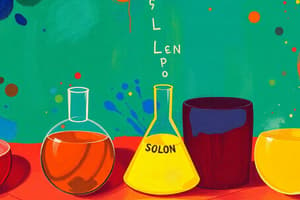Podcast
Questions and Answers
What defines osmotic pressure?
What defines osmotic pressure?
- It determines the osmolarity of a solution.
- It is the pressure required to stop osmosis. (correct)
- It is the pressure required to initiate osmosis.
- It is the pressure exerted by the solute molecules.
What is the substance called that is present in the larger amount in a solution?
What is the substance called that is present in the larger amount in a solution?
- Solution
- Dissolvent
- Solvent (correct)
- Solute
Which statement about colloids is true?
Which statement about colloids is true?
- Colloidal suspensions are perfectly homogeneous.
- Colloids can only be formed in liquid mediums.
- Colloids exhibit the Tyndall effect. (correct)
- Colloidal particles are smaller than solute molecules.
Which of the following describes a saturated solution?
Which of the following describes a saturated solution?
What is a common example of an emulsion?
What is a common example of an emulsion?
What type of solution contains more solute than is present in a saturated solution?
What type of solution contains more solute than is present in a saturated solution?
Which of these correctly describes a hydrophobic colloid?
Which of these correctly describes a hydrophobic colloid?
In which type of solution do non-polar molecules typically dissolve?
In which type of solution do non-polar molecules typically dissolve?
What role does the hydrophobic tail of soap play in cleaning?
What role does the hydrophobic tail of soap play in cleaning?
What is the correct expression for calculating percent by mass of a solute?
What is the correct expression for calculating percent by mass of a solute?
Which concentration unit is defined as moles of solute per liter of solution?
Which concentration unit is defined as moles of solute per liter of solution?
Which formula represents the relationship of osmotic pressure?
Which formula represents the relationship of osmotic pressure?
When diluting a solution, which statement about the moles of solute is true?
When diluting a solution, which statement about the moles of solute is true?
What distinguishes a colloid from a true solution?
What distinguishes a colloid from a true solution?
Which of the following examples represents a solid-liquid solution?
Which of the following examples represents a solid-liquid solution?
How is a sol classified in terms of its physical state?
How is a sol classified in terms of its physical state?
Flashcards are hidden until you start studying
Study Notes
Introduction
- A solution is a homogeneous mixture of two or more substances
- The component present in a smaller amount is the solute
- The component present in the larger amount is the solvent
Types of Solutions
- Solutions can be classified based on the state of the solute and solvent
- Air is an example of a gas dissolved in gas
- Soda water is an example of gas dissolved in liquid
- Brass and solder are examples of solid dissolved in solid
Types of Solutions Based on Solute Concentration
- A saturated solution contains the maximum amount of solute that a solvent can dissolve at a given temperature
- An unsaturated solution contains less solute than the maximum amount that a solvent can dissolve at a given temperature
- A supersaturated solution contains more solute than the maximum amount that a solvent can dissolve at a given temperature
Interactions in the Solution Process
- The solution process involves three types of interactions: solvent-solvent, solute-solute, and solvent-solute interactions
- These interactions determine the solubility of the solute in the solvent
Like Dissolves Like
- Non-polar molecules are soluble in non-polar solvents
- Polar molecules are soluble in polar solvents
- Ionic compounds are soluble in polar solvents
Concentration Units
- Concentration is a measure of the amount of solute present in a given quantity of solvent or solution
- Percent by mass is expressed as the mass of solute per 100 units of mass of solution
- Mole fraction is the ratio of moles of a component to the total moles of all components
- Molarity is the number of moles of solute per liter of solution
- Molality is the number of moles of solute per kilogram of solvent
Dilution
- Dilution is the process of preparing a less concentrated solution from a more concentrated solution
- The amount of solute remains the same during dilution
- The equation MiVi = MfVf is useful for dilution calculations
Osmotic Pressure
- Osmosis is the movement of solvent molecules from a dilute solution to a concentrated solution across a semipermeable membrane
- Osmotic pressure is the pressure required to prevent osmosis
- The osmotic pressure is directly proportional to the molarity of the solution, the gas constant, and the temperature
Colloids
- A colloid is a dispersion of particles of one substance throughout a dispersing medium of another substance
- Colloidal particles are much larger than solute molecules
- Colloids exhibit the Tyndall effect, which is the scattering of light by colloidal particles
Types of Colloids
- Colloids can be classified based on the state of the dispersed phase and the dispersing medium
- Examples include fog (liquid dispersed in gas), smoke (solid dispersed in gas), whipped cream (gas dispersed in liquid), mayonnaise (liquid dispersed in liquid), milk of magnesia (solid dispersed in liquid), plastic foams (gas dispersed in solid), jelly (liquid dispersed in solid), and certain alloys (solid dispersed in solid)
Hydrophilic and Hydrophobic Colloids
- Hydrophilic colloids are water-loving
- Hydrophobic colloids are water-fearing
Stabilisation of a Hydrophobic Colloid
- Hydrophobic colloids can be stabilized by using surfactants
- Surfactants have both hydrophilic and hydrophobic ends, which allow them to form micelles that stabilize the colloid
The Cleansing Action of Soap
- Soap is a surfactant with a hydrophilic head and a hydrophobic tail
- The hydrophobic tail dissolves grease and the hydrophilic head interacts with water
- This forms micelles that trap grease molecules, allowing them to be washed away by water
Studying That Suits You
Use AI to generate personalized quizzes and flashcards to suit your learning preferences.




